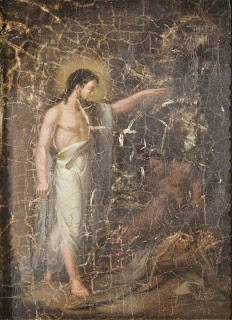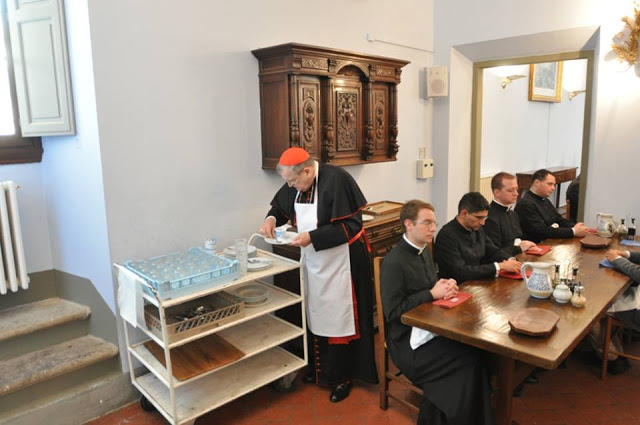In some parts of the world, May seems like a long time coming. Here’s an amusing performance of Praetorious’ Philou. Enjoy it as a pleasant reminder of the secular that ran alongside the sacred, which we sometimes forget. And a celebration of multi-tracking, if that’s your pleasure.
Aurora lucis rutilat
The light of dawn is reddening,The heavens’ morning praises spring,The earth exults: “The morning! Hail!”While hell’s sad dwellers groan and wail.Our King, the victor in the strife,When death was smashed apart by life,Has trampled hell triumphantlyAnd captive led captivity.The Lord, whose barricade of stoneThe soldiers kept sharp eyes uponIn vict’ry conquers through that gateAnd rises forth in pomp and state.“The Lord is risen from the dead!”The splendid angel loudly said.And hell is evermore left freeTo grumble in its misery.Be this our thought through all life’s days,Our Easter joy, our Paschal praise:The grace in which we are rebornWas won in triumph on that morn.Jesus, to You let glory rise,Who vanquished death and won the prize;With Father and the Spirit blest,Be endless ages’ praise addressed.
Trans. c. 2013 Kathleen Pluth
Courses at Catholic University of America this summer
I was asked to remind readers of the courses being offered under the auspices of the Ward Centre at Catholic University of America.
So here’s the information and where to go to learn more:
The Charms and Perils of Beauty
I’m not a great reader of sermons. (Actually, not a great listener either.) However, Fr. Cipolla of St. Mary’s, Norwalk, Connecticut provides a lovely meditation on the risks and rewards of beauty in the search of truth and goodness.
It’s over at Rorate Caeli and is definitely worth a read by those who love fine liturgy and music.
Many thanks to Fr. Cipolla, a man who always knows what he’s talking about.
Servant leadership
New FSSP Recording
This is from the Catholic News Agency.
Tucked away in the low, rolling hills of eastern Nebraska is Our Lady of Guadalupe seminary, the international school for English-speaking seminarians of the Fraternity of St. Peter (FSSP), a Roman Catholic group of priests dedicated to celebrating the traditional Latin Mass….
For their first album, the priests and seminarians chose to record the chants of the Requiem Mass, Latin for ‘rest’ – the funeral Mass in the Latin rite.The album Requiem, produced in collaboration with De Montfort Music and Sony Classical, will be available May 12 on Amazon. De Monfort Music specializes in chant, polyphony and all areas of sacred music with a concentration on singing orders and communities well trained in this repertoire.
I’m not certain this –
Although most people know the Requiem via the celebrated version by Mozart, the composer was himself inspired by Gregorian chant, explained Fr. Zachary Akers, music director of The Fraternity and a singer on Requiem, in a press release.
is accurate.
(Woeful numbers of people hear Sarah Brightman in their heads at the mere mention of the word, requiem.)
Fr. Garrick Huang, co-music director of The Fraternity and a singer on Requiem, noted that Gregorian chant is thought to have roots both in the ancient Western and Eastern cultures, creating a sounds that is a cross-section of many cultures….
While the music, and the black vestments of the priests during a Requiem Mass, inspire natural feelings of sadness and mourning, there is also present an element of hope.
“It’s not a morbid sadness because we have hope that God is merciful and that he will bring this soul to heaven,” Fr. Akers said. “The calmness of the chant reveals a spirit of rest or repose, which is what the very word requiem means.”
CMAA Courses on the Ward Method in June, 2017
Have you wondered about the Ward Method?
Thought it might change the way you teach music with children? For the better?
Did you do the basic course and you want to take it further?
The Church Music Association of America (CMAA) is offering you a chance to find out about Ward and take your practice deeper this summer at Duquesne University in Pittsburgh, June 26-30, 2017.
There will be two courses offered.
Ward Method I – That All May Sing will be taught by Scott Turkington. Participants will learn the basic principles and the practice of this method developed by Justine Ward in the early 20th century and how it can be used with our 21st century children. Its fundamental principle is that all children can learn to sing, not just those with natural gifts.
Ward Method II – Intermediate moves beyond the first year. Wilko Brouwers will share his expertise and experience with the method to pass on more advanced techniques. It will expand on the training in Ward Method I.
Both Scott Turkington and Wilko Brouwers are experienced and gifted teachers, not only of children, but of teachers as well.
The CMAA is convinced that this method has great value for developing future generations of singers, both those in the choirs and those in the pews. You can be part of that project.
You can learn more details about the courses and register at musica.sacra.com by following this link:
CMAA Summer Courses.
Help the past and the present build our musical future!


